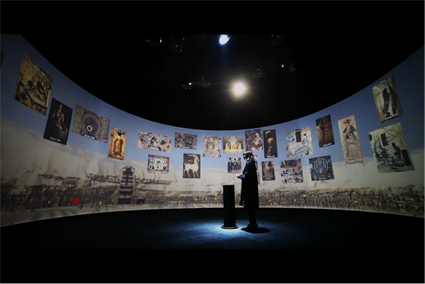'Pure' experience, in the round
Urszula Dawkins, Pure Land, iCinema

Pure Land: Inside the Mogao Grottoes at Dunhuang
courtesy iCinema
Pure Land: Inside the Mogao Grottoes at Dunhuang
The 742 world-heritage-listed caves of Dunhuang were laboriously carved out of a sandstone escarpment in north-western China. Their Buddhist murals are both astonishing and highly fragile – the oldest are well over 2000 years old. Pure Land recreates one of them, Cave 220, at 1:1 scale in virtual 3D.
Essentially, Pure Land is a diorama, which we’re guided through by creator Sarah Kenderdine. Donning virtual-3D glasses we enter the circular space. At first, it appears like any other interpretive display – it’s an in-the-round photo representation of the sandstone cliffs over which hover thumbnails denoting different caves. Kenderdine selects Cave 220 and we’re off…
Plunged into darkness, our first glimpse of the cave walls is via a pale circle of torchlight which dully illuminates patches of the intricate artwork on the walls: this is what a visitor to the physical cave would see, and it’s easy to imagine the damp smell, the dust underfoot. Then the mode is switched and we see the entire cave and its majestic figures, and the extension and limits of the space become palpable – it feels like we’re ‘really there’ – which is ironic, of course, because the obscured, 2D ‘torch view’ is actually closer to the ‘real’ experience.
From here, we’re subject to the whims of a floating circle – reference to the magnifying glass which a scholar of the artworks might use in the caves. It hovers like a perfect smoke ring away from the wall, homes in and clicks, magnifying details in larger circles that hang at arm’s length from the viewer. A range of effects brings to life aspects of the murals – restoring the original, vibrant pigments to some sections, enlarging details or animating objects – lanterns are lit and ribbons flutter. Oxidised figures regain their skin tones. Stringed and percussion instruments float off the walls and rotate to the sounds of traditional music.
It’s a museum display, an experience of art rather than an ‘art experience’. And yet two 3D-animated dancers with twirling ribbons are magical: at around 2/3 human stature it’s as though their size becomes a metaphor for their distance from us across time. They are there in the space in front of us, oblivious to us, moving in perfect unison and we are voyeurs of their ancient world. This image, of all, sticks in my mind after leaving.
The utter opposite of Ryoji Ikeda’s datamatics [ver 2.0], Pure Land aims at pure representation of the real. But as Kenderdine explains, it’s not simply an ‘interactive experience’ designed only for the museum visitor or to preserve the caves. To understand the murals themselves, she says, requires a spatial relationship: the alignment of figures in the actual caves – north, south, east or west – is crucial, and grasping the meaning of the murals requires a knowledge not only of the figures, objects and elements, but of their spatial relationship to one another.
Pure Land is also located firmly in the notion of verity – unlike one of its (now-cancelled, unfortunately) iCinema companions, Scenario (a poetic, interactive fantasy involving an AI-equipped humanoid imprisoned in a basement – see RealTime 104). The differences seem polar: Pure Land aims to ‘take us there’ – where ‘there’ is a real place. We remain spectators while navigating – though poetic and emotional engagements like my own with the dancing figures are possible. With so many different ways of viewing this ‘real’ place, the result is a kind of meta-verity, in which much more can be seen – and perhaps responded-to – than if we were actually there.






